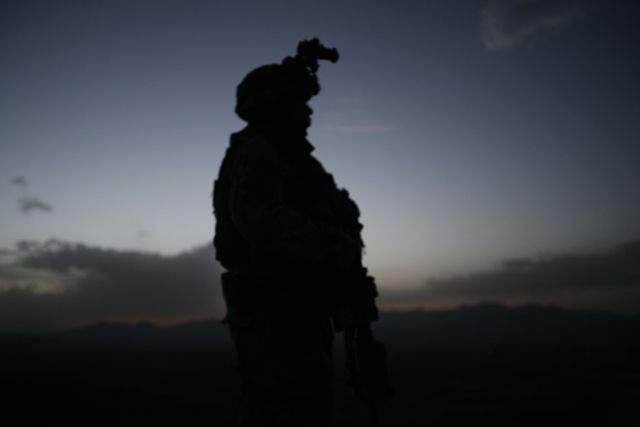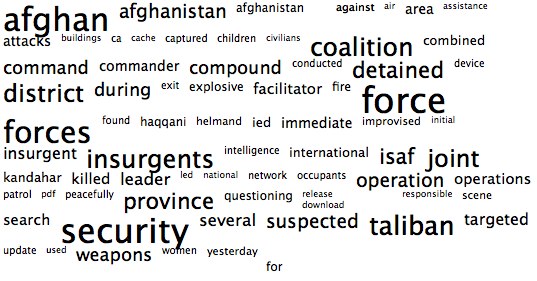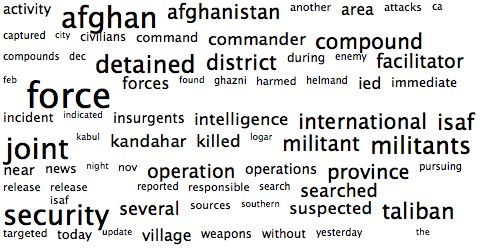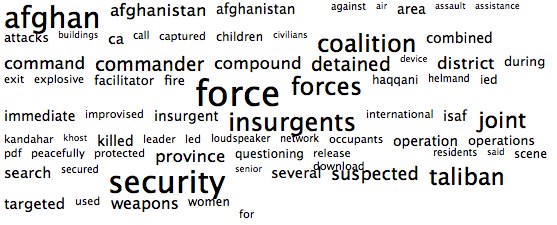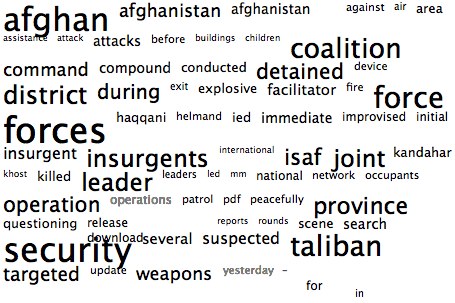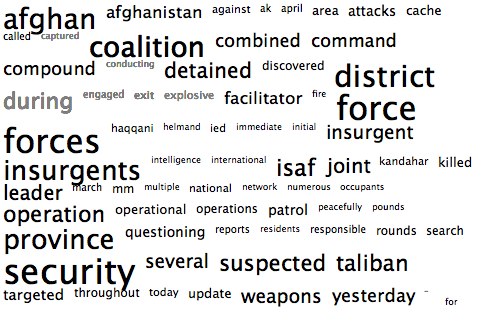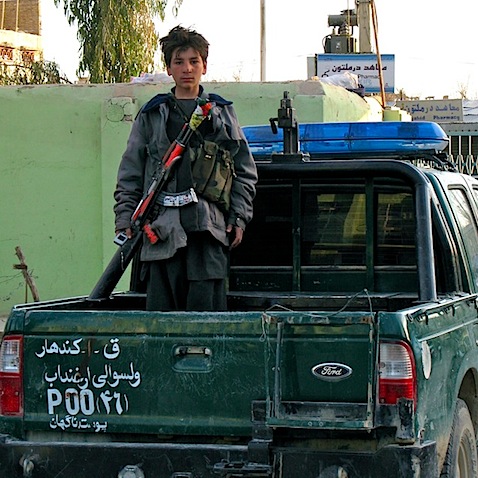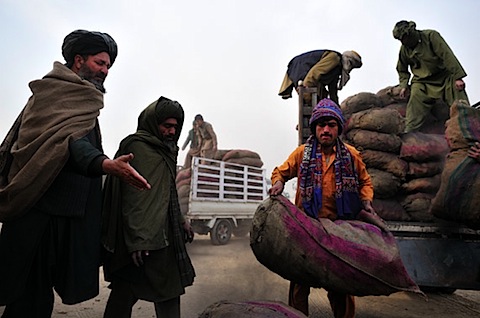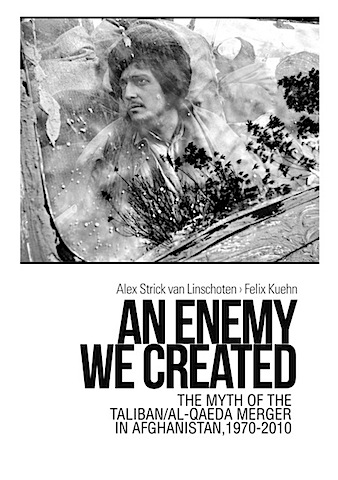The Taliban issued a new edition of their Arabic-language Al-Somood magazine a few days ago. You can view the original on Aaron Zelin's excellent Jihadology website. The most interesting articles, I found, were the two relating to the Taliban's recent prison escape from Sarpoza jail. There has been a lot written about the escape, but we've heard relatively little from escapees. These two articles offer a fair amount of new detail. Of course, al-Somood needs to be taken with a pinch of salt, but the accounts are interesting nonetheless.
Accordingly, full translations of the two articles are presented below, exclusively to this website.
{Part 1: pp12-14 of al-Šumūd (Steadfastness), 5th year, volume 60, Jumada al-Thaniya 1432AH/May-June 2011}
The Prison Break Story
How Fiction Became Reality
By Abd al-Ra'uf Hikmat
Kandahar Prison
Kandahar's main prison lies in the Sarposa area, north of Kandahar-Herat highway. It is considered the largest state prison in south Afghanistan with its capacity to hold thousands of prisoners. It comprises a main gate and multiple segments; it is also surrounded by high and impenetrable walls.
This prison has essentially been built professionally, with the establishment of high surveillance and watch towers in its four corners. It is also surrounded by a number of underground walls, further to its high [overground] walls, to prevent digging tunnels to the outside.
Notwithstanding this impervious building and tight security measures, this prison has become the scene of a fascinating story not only in the Afghan domain but internationally as well. Over the past eight years, political prisoners have been able to escape on three occasions. The first time saw in June 2003 inmate mujahideen of the political ward digging a tunnel from within the prison to the outside, thus freeing all of this ward's prisoners who totalled 45 via the tunnel. Then in June 2008, the Islamic Emirate launched militant martyrdom attacks on this prison that caused the death of all the prison's guards and released close to 1,200 inmate mujahideen. Subsequently, Americans and Kandahar officials took care of maintaining this prison; Canadian forces trained special policemen to guard the prison; watch towers were increased and monitoring cameras installed; all the prison was encircled by a deep and wide trench. Despite all these measures, the mujahideen were able for the third time to release 541 prisoners following a long planning on the 25th of April of this year, 2011.
Pure Fantasy
One of the surprising mujahideen squad in the city of Kandahar, who by his connections gained full knowledge of the inside and outside of the prison, pondered one day whether it could be possible to dig a tunnel from the inside of a house on the other side of the street to the prison as a means to releasing the prisoners. This fantasy and imagination seemed laughable at first even to its owner; he dared not share his opinion with others. But, after more time and continued thinking, he reached a conclusion. On one of these days, while he was riding a motorcycle with two of his comrades, he shared that view with them. They thought it impossible initially and deemed it a fruitless, dangerous attempt. Finally, they placed their trust on God and shared their opinion with the mujahideen high command in Kandahar. With guidelines from the command, the aforementioned four revealed [to] their trusted comrades their decision to implement this plan regardless of its risks and even if it looked impossible.
Concrete Workshop
Six months ago these committed mujahideen rented a house opposite the south corner of Kandahar prison. The old house rooms were in disrepair. Initially they built a new room. Then they brought in all necessary [equipment] and machines to make concrete, hiring a number of workers who worked during the day. But in the afternoon, when the workers left, the mujahideen stayed under the pretence of guarding. It was during that time that they proceeded to dig the tunnel from within the room they had just built.
Hard Labour for Four Months
At first, four mujahideen were plodding through this operation. Their work method was the following: one was to hit with the pickaxe, digging the tunnel, while the other three were to move the soil. The tunnel was narrow, the soil could not be moved out by wheelbarrows, so some operation planners went to the market and bought a number of children bicycles, removing their small wheels and fixing barrows on them. They were able to prepare wheelbarrows that suited their task. Now they filled these barrows with soil, pulling them by a rope to the tunnel opening and collecting the soil there before moving it to the lorry. In the morning, when the soil lorries headed to the city for its sale, mujahideen would bring in their soil-filled lorry and sell it, thus getting rid of it.
For two months, four mujahideen were working in the tunnel digging. Then their number increased to eight mujahideen. Now they were digging four meters every night. When their continued work reached 100m, they faced the issue of ventilation and lack of oxygen; nevertheless they carried on until cutting a distance of 150m. At this point it was terminally difficult to continue working, due to oxygen lack, and work carried on no further. In the beginning they tried a ground fan; it resolved the ventilation issue but it was winter and the cold weather caused headache. Then they made an air-pumping machine, delivering air by a pipe from the outside to the inside of the tunnel. This was the best method to resolve the ventilation and lack of oxygen – the machine worked quietly by a charged battery. But they then realised the risk of their digging a tunnel under the road that carried the heavy enemy vehicles to the inside of the prison: There was a possibility of a tunnel collapse under intense vehicle pressure. The question was how deep was the tunnel to be dug to exclude that possibility. As an experiment, they parked a lorry atop the tunnel; it suffered no damage, assuring them that it would not suffer because of enemy vehicles. The tunnel was 2.5m deep between the house and the public road, but as a precaution they deepened it further. Four months passed and the tunnel went 220m, a well iron pipe surprised them before realising it was not a prison pipe but a pipe to a village south of the prison. In fact, the tunnel diggers, having no map, deviated from the correct path to the right, crossing the road and reaching a village close to the prison. Here they recognised that the target could only be reached with the prison map and distance measuring tools.
One and a Half Months of Efficient Work
The tunnel diggers who lost their way and made an extra 120m now downloaded the prison map off the internet and by which were able to pinpoint the prison location. Using earth measurement tools they re-dug at the distance of 100m of the tunnel directly towards the prison. However, with the passing of the winter, night was shorter. Consequently they increased the number of labour mujahideen until they reached twenty-one. Furthermore, earth evaporates less in summer, so ventilation was a lesser issue, work faster and more effective. By digging 166m they reached the middle of the prison (it must be added that the Islamic Emirate's site mentioned the distance dug by mujahideen including the distance dug by error, giving a total of 360m, when the precise distance, excluding additional distance, was 266m. Noteworthy to add the tunnel's 70cm height and 60cm width).
The prisoner mujahideen were in two separate locations within the prison: Most were in the political ward, where they numbered 530, but a small number was in a room called 'Tawqif Khanah' [arrest room]. The tunnel was dug first towards Tawqif Khanah room, as it held a linked mujahid aware of the case. He used to hit the ground for a reason and no reason in order for the tunnel diggers to recognise whether they were ahead or behind or at the target. Thus they were able to pinpoint the place, but for verification they raised a blade to the room, until the prisoner assured them of hitting the target. They moved on to the political ward. Five days produced further 23m, reaching the political ward where its room 7 held two linked prisoners aware of the case. The aim was to take the tunnel to room 7. Here again the tunnel diggers wanted to raise a blade to ascertain and avoid any error when opening the tunnel to the prison. The mujahideen were hesitant: were they under room 6 or 7? To keep the matter secret when the blade would be raised, the two prisoners held a Qur'an completion [session]; all the rooms were vacant, the two aforementioned prisoners left, one to room 6 and the other to room 7. When the blade was raised they realised they were under room 6, contrary to their expectation. Then two further meters were dug until reaching room 7. Now they could not vacate the rooms with the Qur'an completion excuse again, so the mujahideen used the afternoon time when prisoners would go out to washing rooms and get prepared for the noon prayer; the blade was raised and it made it successfully to room 7. The opening place was specified for the escape operation day. It should be added that the blade raising operation was made subsequent to a wise and interesting plan: The prison ground was about 2.5m above the tunnel, with the tunnel's height of 70cm, how a long blade could fit through this tunnel to reach the prison ground? The mujahideen cut iron blades of 50cm length and joined them together; when they were raising a blade 50cm by a car lift, they would fix to it another blade and raise it by the lift. Thus they prepared for the dismantling of blades a machine that would be attached to each blade then hit by a hammer downwards. This was how they were able to pinpoint the location precisely.
Prison Release Plan
Following the tunnel digging to the desired target, the persons responsible for digging finished their work. They requested from the Islamic Emirate's high command guidelines concerning the prison release planning. The Kandahar Province's and high ranking Islamic Emirate's officials held continuous consultations for the secure and successful delivery of the release operation. Subsequent to consultation, the following plan was adopted.
The mind behind this operation, who on his own hit the pickaxe laboriously to dig 300m of the tunnel, would himself be the commander of the prison release operation as well. He would adopt during the operation ad-hoc plans as needed. The high command would tell him about whatever might happen. The operation would be kept secret until the last moment of execution. Links would be established with the linked brothers within the prison; they would be prepared inside the prison to take the responsibility of organising and moving out the prisoners according to the plan. Similarly all decisions were taken, delegating the operation command to the aforementioned person.
Release Operation
For the best execution of the operation, precautionary measures were checked and preparatory processes were taken again to solve the ventilation problem inside the tunnel. A powerful machine to pump air was operated while the pipe laid inside the tunnel was holed in ten places to deliver air to all parts of the tunnel. Forty-five lamps were also switched on for illumination of the tunnel. As a precautionary measure, a team of to-be-martyrs were sent to the prison neighbouring areas to launch a militant attack if necessary.
For the operation concealment and fear of being exposed, the operation-tasked person chose five mujahideen, out of the 21-mujahid team as stated before, on the operation day, so he would not lose all his friends, God forbid, if some bad thing were to happen. Subsequently, the release operation team was six persons. These six told the three linked mujahideen within the prison at 9am, one of them was in the Tawqif Khanah room and two in the political ward, that the coming night would be the date of executing the operation, God willing, in order to be prepared. The two linked persons in room 7 of the political ward, for the purpose of telling the rest of prisoners about the case at an appropriate time, prepared some hospitality in their room and invited one or two persons from each room.
The operation commander planed as follows: four brothers of the six would enter the tunnel, two would start working to open the tunnel to the Tawqif Khanah room and two would work to open a tunnel to the political ward; the remaining two would be outside the tunnel. The mujahideen would extend a telephone wire inside the tunnel, establishing a connection between brothers outside and brothers inside and allowing exchange of information e.g. where the work reached and what need be done, etc.
The four brothers entered the tunnel with car lifts and] solid iron [poles]. They started opening the tunnel to the "Tawqif Khanah" room and the political ward. At about 10 o'clock they easily opened the "Tawqif Khanah" room floor with the lift. The prisoners exited. But as they had among them two spies from the prison administration disguised as prisoners, one was made unconscious by the mujahideen and the other taken out via the tunnel handcuffed to prevent him from causing noise.
As for the ground of the political ward, its construction was heavy-duty and it took the mujahideen long to make a hole through. The lift was raising the (cement) concrete ground but due to blocked air in the tunnel it was difficult to hole. After many trials the mujahideen were able to smash the ground. After cutting a huge hole to the ward's room 7, the brothers down the tunnel gave four pistols and four daggers to the linked brothers for use in the operation. They also gave them a telephone handset to establish a connection with the brothers out of the tunnel. Thus the prisoners went on to exit until 1.30am (April 25th, 2011); approximately 250 prisoners exited this way. But the work team realised that if exiting would carry on as such it would last until 2 o'clock, while the plan was for the prisoners not to wait long [outside] as waiting till dawn would be dangerous leading possibly to a botched operation. Therefore, the team postponed the exiting of prisoners for half an hour. They started letting prisoners out again at 2am. By 3am no prisoner was in this ward.
We would like to add that all prisoners were being inspected at the entrance and exit of the tunnel. When entering, their luggage boxes would be taken as carrying them would have caused their delay and risked their re-arrest. When exiting, any money surplus to 3,000 rupees would be withheld and granted to those with no money.
While leaving, it was properly organised. The tasked brothers would wake up the prisoners of each room in turn and guide them to the tunnel. At the exit they would ride the lorries parked at the house; each lorry would carry 36 persons. It was 3:10am when [all] the prisoners left and lorries were allowed to depart. The lorries left from the yard but some brothers headed to the town suburbs on foot – they were instructed to cut a distance before returning to the Kandahar-Herat highway after daybreak and to leave the yard using taxis.
It must also be added that two of these lorries that were transporting the prisoners made two journeys to transport them. By 3:30 or 4:00am no prisoner was in the prison neighbouring areas. It is noteworthy to say that by God's favour and then the mujahideen carefulness and sagacity, the enemy felt nothing throughout concerning what was going on next to it – the house used in the operation was about 20m from the enemy's watch tower that oversaw easily the middle of the house. A surveillance camera was also installed facing the house door. Nevertheless and thank God, it noticed nothing.
The Operation's Expenses
We must add that there were no body losses and the mujahideen shot no bullet. Furthermore, the financial expenses were much lower than expected. According the person in charge of the operation and its planner, the expenses during the operation's five months reached about 900,000 Afghanis (i.e. US$20,000). These included the house fees, mujahideen food, lorry charges and other equipment the mujahideen left in the house after the operation.
On the last day of the operation, the person in charge who built the concrete workshop for the operation execution stated: we sold during the five months 150 concrete blocks, making much profit. He added: After the operation and the final exit, when the house gate was locked, we left the air pumping machine, 45 lamps, 10 concrete blocks, a pole valued at 50,000 Afghanis, 2 power generators, 2 wheelbarrows, 2 car lifts and some building material; but this historic house benefited us much that these expenses seemed nothing.
{Part 2: pp24-25 of al-Sumud, 5th year, volume 60, Jumada al-Thaniya 1432AH/May-June 2011}
Story narrator: Muhammad Idris
Editor: Habib Mujahid
I was the Second Person to Exit
(A Prisoner Tells his Story)
Muhammad Idris, a 23-year old Kandahar resident, had for many years been launching surprise operations in Kandahar city under the Islamic Emirate's command. He was caught 7 months ago by the enemy in Kandahar city and sent to Kandahar prison. He said he had yet to be tried. Since his captivity, he lived in room 9 of the huge prison with other 15 mujahideen. He was the second, out of hundreds, to exit the prison via the tunnel dug from the known house to the prison.
Let us allow Muhammad Idris to tell us his story himself:
The Kandahar prison is thus established: in the middle of the political ward there is a vast yard. All room doors open to this yard; so the ward's main gate is always locked while the internal room doors are always open. Therefore, prisoners are able to enter other rooms with no difficulty; they gather for the communal prayers as well.
The prisoners of the room that the tunnel reached hosted on Monday night their friends and invited from each room one or two persons. To the hospitality this ward's prayer imam, a scholar prisoner, was also invited, while I represented my room. So to the supper we went.
We had our supper. Then Mawlawi, the prayer imam, started talking. After some beneficial advice, the sheikh [imam] started telling the persons present about the release operation plan. None of us knew anything about the subject until then. During his talk he told the prisoners sitting in the room: "Tonight an operation to free and release us will be made; we better be ready for it". "Anyone of you exiting is ordered not to operate his mobile until tomorrow afternoon. If he talks on his mobile he must be careful not to mention how he got out," he added. Following these guidelines he told us: "Keep mentioned God sincerely so he brings this operation to success." We all started mentioning God. Within half an hour all brothers were busy with praises and prayers. Then the brothers who were aware of the plan came to the mentioned room. They cleared the items and mat in a particular part of the room. Moments later the cleared area was knocked at, and the brothers in the tunnel under the area put a car lift underneath. They continued the pressure until breaking the (cement) concrete ground. As this place was low, they brought with them many robust poles in order for the lift power to reach the concrete [ground]: they would place the poles on the lift then raise it. They repeated this two or three times until a huge hole was opened in the middle of the room.
Thereafter, the brothers inside the tunnel gave the linked prisoners a number of pistols, daggers and knives. They also gave them a box containing a telephone headset, video camera and other devices that I did not recognise. I looked to the tunnel and saw two mujahids: one who gave the box and another. Both retreated and headed to the other opening. At this point the prisoner release operation was delegated to the prisoner mujahideen who were aware of the operation. They linked the telephone headset with the wire, establishing a connection with the mujahideen on either side of the tunnel: inside and outside of the prison.
These operation-aware prisoners distributed then the arms among themselves, adding a number of trusted mujahideen to them. This ward was holding 2 rooms of criminal prisoners [as well]. There were also a number of state spies among the prisoners. So the decision was made if such spies were to cause trouble or attempt telling the prison guards we would kill them by these arms and knives. They said that such an operation would be difficult to comprehend; if any brothers would not trust it and refuse leaving, we would force them with these arms to exit.
Meanwhile, the operation-aware prisoners said to persons present prior to going down the tunnel: "When you go out on the other side of the tunnel, you will meet a number of mujahideen. They will take surplus money from you, mobiles and other items. They will allow you neither to talk nor to leave; listen to them in whatever they say to you." Alright, will do, we said. Now I was the second in turn in the group sitting in the room to the tunnel, the first prisoner went down and I followed. The tunnel was wide, but not very much, I mean we could walk kneeling or crawl easily. But the mujahideen dug it fantastically: Every 15m there was a lamp, it was very bright. Similarly the mujahideen laid a 6″ diameter plastic pipeline along the tunnel for ventilation. At its start they operated a device for pumping air in, and made small holes in the tunnel. We thus felt no lack of air in the tunnel. Additionally two wires were laid in the tunnel: One was for the telephone and I did not know whether the other was for electricity or otherwise. We went about 15 minutes inside the tunnel until reaching the other side: One went in front of me and a large number were behind me. Upon reaching the tunnel exit there were 15 armed mujahideen. They meticulously inspected all people exiting from the tunnel, taking from all their mobiles and sim cards. If one had money they would leave 3,000 rupees to him and take the rest. There was a coat where they would put the money they took from us in. As for prisoners with no money or less than 3,000 rupees, they would give them from the collection in order to have 3,000 rupees. This was the best method for everyone to have money that would help with errands until reaching their destination. After exiting I saw three mujahideen I knew, so they joined me to them in the operation execution. In the house were six transport cars. The brothers told us to make anyone exiting from the tunnel get in the cars after inspection and ordered them to say nothing but mention God discreetly, as close to the [house] yard was a prison tower; if disorder was to occur the enemy could notice. This way the prisoners exited from the tunnel and we made them ride the cars. Whenever a car would be full we would cover it. When all brothers finished, some friend said: "Not much space is left in the cars. Brothers who know the area and town alleys should go on their feet to the town suburbs". The house gate was facing the prison while its back faced a residential area. We made a hole in the back wall and through which the brothers who could not be taken by cars walked to the town suburbs.
But I and four of my friends who were of the city residents discussed it between us and agreed to go to the city. At this point the cars left the house and the five of us left minutes later to the street. We waited a little while on the pavement until a taxi came that was heading to the city. We rode it. It was 4am. Upon heading to the city the police stopped our car at "Dand" roundabout then told us by his hand to go. The same inspection process was repeated at "Madad" roundabout; the policeman said nothing. We reached the city and we had our rescue; salvation.
I need add that the prisoners in the political ward of Kandahar prison are all mujahideen. Nearby there was another ward called Tawqif Khanah where a prison room held mujahideen. From the main tunnel the mujahideen dug a secondary one to that room, allowing 10-15 prisoners of mujahideen to exit that room, thank God.
In the morning, when I walked about the town and was following the news, in my view until 8am the enemy felt nothing concerning the runaway mujahideen from the prison, as I saw no mandatory checks being carried out in the city. After 8am, the enemy started action. The prison guards used to count us twice: at 8am and in the afternoon. I think that when they arrived to the political ward at 8am to count the prisoners, they found none. Then they started searching and looking for them.
To my knowledge, not a single mujahid remained in the prison's political ward, but there was a room for the mentally ill and they remained inside the prison. As for the other wounded and sick prisoners, all were freed. There was even a wounded prisoner with two iron bars in his legs, during his walk inside the tunnel the two bars were broken and he fainted of extreme pain. Nevertheless, the mujahideen carried him in this condition, got him out of the tunnel and transported him by car.


